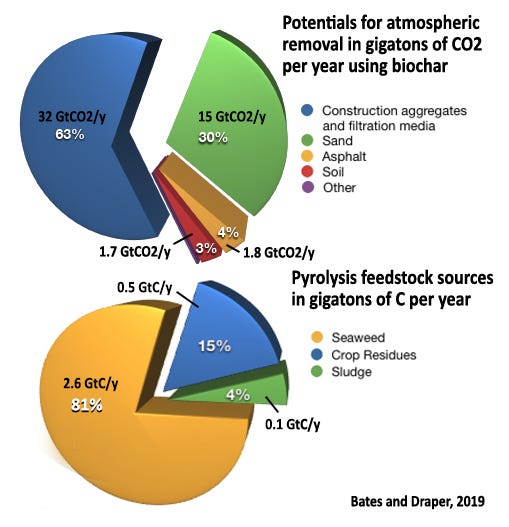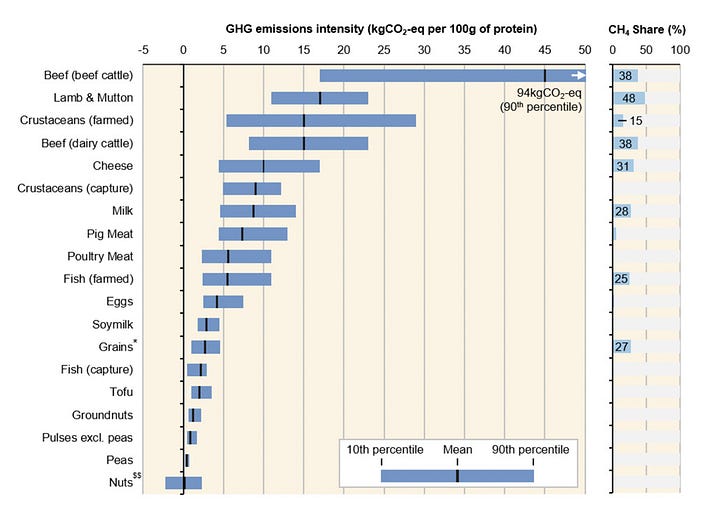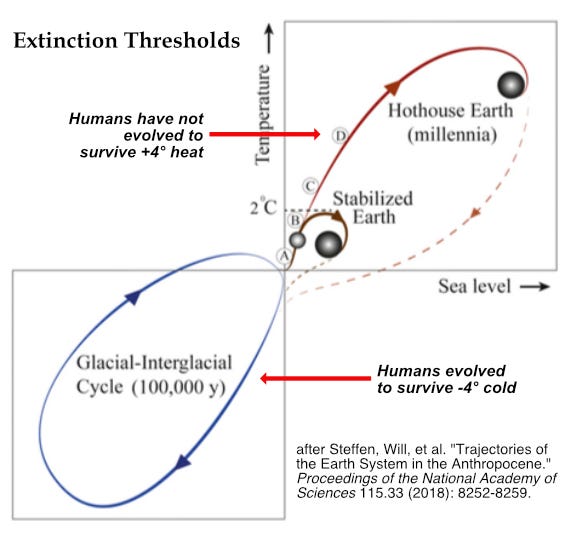The Age of Climate Limits
"Science has given us a three year deadline to end growth as we know it."

I’m lacking words for this…. What is suicidal is our inability to take the decisions and enact the behavioral changes that we perfectly well can in order to align our planet with the Paris Agreement. That’s the problem. There is nothing new that any report can tell us about what we should be doing. The gap that we identified years ago is not closing; in fact, it’s enlarging. That’s the news. It’s tragic.
Scornful daddy António Guterres, UN secretary-general, said the kid was a “file of shame, cataloguing the empty pledges that put us firmly on track towards an unlivable world.”
Climate activists are sometimes depicted as dangerous radicals. But the truly dangerous radicals are the countries that are increasing the production of fossil fuels.
Working Group Three
To briefly recap, Working Group I’s report was a “where we are” in climate science. WG2’s was “what we can expect.” When the WG2 report landed in March it got buried behind the ongoing pandemic and the war in Ukraine but essentially said we can expect the worst if we keep on this track. If that happens, we cannot adapt, and we won’t survive. WG3’s report, the one worth waiting for, is “what we need to do, urgently, in order to survive.” The 3676-page report covers:
- Socio-economic scenarios, modeling and transitions at the global, regional, national and local scales including integrated assessment approaches.
- Energy systems including supply and energy demand sectors (e.g., industry, transport, buildings).
- Mitigation responses in agriculture, forestry, land use and waste.
- Consumption patterns, human behavior and greenhouse gas emissions, including economic, psychological, sociological and cultural aspects.
- Policies, agreements and instruments at the international, national and subnational levels, including those at the city level.
- Technology innovation, transfer and deployment.
- Financial analysis for each for each response options.
The first thing you notice about the report is that the cover is a photo from the Eastwhins neighborhood in the Findhorn ecovillage. Superinsulated co-housing apartments adjoin each other, facing the equator, topped with solar PV and water heaters, rain barrels, and an integrated sunspace/greenhouse fronted by an outdoor raised bed garden, a paved biking/walking trail for home deliveries, a common green, and bicycles. It is not an artist’s rendition. That particular ecovillage is in the far North of Scotland with a long, dark winter, but it could as easily be Ecovillage at Ithaca, Seiben Linden in Germany, Earthsong in Auckland, or ten thousand similar places. This we have done since the UN opened the chapter on the climate emergency at the Stockholm Earth Summit in 1972.
If Covid taught us anything, it was that the status quo is a frail construct. It can vanish in an instant, or at least over the course of a few weeks. This is what the people in Ukraine witnessed, at least one by a hail of machine gun fire as he bicycled to the grocery. It is what happened to those in Lismore and Byron Bay who saw their homes rain bombed underwater to the rooftops for the second time in a month, or to those who watched their lifetime possessions vanish in wildfires of scale and speed no one had imagined possible. The shock of sudden change is how a two-year (and soon to be longer) pandemic convinced so many to leave their professional careers and switch to a different life path rather than go back to what they had been doing before. We have been shaken from dreary normalcy and been made aware of how precarious the world of our making has become, and how we could be spending our days in more meaningful pursuits.
Many think the solution to climate change is public education. I don’t. I think people know. Most just don’t want to admit it, or do anything, unless they have to.
The report draws together the connection between reversing climate change and achieving the UN’s sustainable development goals. To put an ecovillage image at the center of the visioning process sent a powerful message.
Even more significant than the cover art was the final paragraph in the conclusion section of the 3676-page report. In the considered opinion of the 1000+ top climate scientists, what the world needs most is ecologically aware and socially innovative experimental communities that network with each other and provide educational outreach and positive examples of a better world.
Indeed, transitions require an examination of the role of values, attitudes, beliefs and the structures that shape behaviour, as well as the dynamics of social movements and education at multiple levels. Likewise, technological and social innovation both play an important role in enabling transitions, highlighting the importance of multi-institutional and multi-stakeholder actors building institutional support networks, facilitating collaboration between sectors and actors, and promoting learning and social change.
Systems-oriented approaches, which holistically address the intersections among climate, water and energy (for instance), have significant potential to reveal and help avoid trade-offs, foster experimentation, and deliver a range of co-benefits on the path towards sustainable development.
Strategies to Repair the Climate
To paraphrase the IPCC report, ecovillages (and also Cool Labs):
- Examine values, attitudes, beliefs and the structures that shape behavior
- Employ the dynamics of social movements
- Reform the pedagogies of education at multiple levels
- Use technological and social innovation to enable transitions
- Stress the importance of multi-institutional and multi-stakeholder actors
- Build institutional support networks
- Facilitate collaboration between sectors and actors
- Promote learning and social change
- Favor systems-oriented approaches which holistically address the intersections and relationships of seemingly separate elements
- Reveal and help avoid trade-offs
- Foster experimentation; and
- Deliver a range of co-benefits on the path towards [sustainable] regenerative development.
The report could not have set the agenda any better.
If humanity still needs a climate strategy, I think these thousand scientists, finally reaching their difficult 150-hour marathon consensus in the early hours of Monday morning, provided it. Our effort must address the existential issue of our era: changing our cultural habits and deciding to live as if there will still be a tomorrow.
We could stop there, but if you are a glutton for punishment there is more. Here are some things the IPCC got wrong:
- “Unabated” coal must be “completely” phased out by 2050. The “U” word is inserted at the insistence of coal producers (Joe Manchin, N. Modi, V. Putin) who still believe “clean coal” is a real thing. Instead, all coal should be phased out by 2025.
- IPCC still forecasts that economic growth, coming on the back of ever growing energy supply, will continue into the indefinite future. There is little recognition of the caloric return of different energy types, EROIE, or rare mineral depletion — technocornucopian bias.
- The Carbon Budget. Going all the way back to AR-1, IPCC has followed the chimera of a carbon budget that would allow underdeveloping countries (India, Nigeria, etc) to make up for the lost ground stolen by the overdeveloped nations in the 19th century by continuing to emit — and grow emissions annually — long after everyone else is forced to curtail. Originally the budget was 450 ppm, but when it was realized that would take us to 3 to 5 degrees warming, it was cut to 350, and then replaced with the 2 degree goal. This report says “a significant but very small carbon budget remains” to limit warming to 1.5°. It says the path to limit warming to 1.5° is extremely narrow, therefore this small budget should be used only by hard-to-decarbonize sectors, like steel mills, maritime shipping and airlines. This is preposterous! Even if all emissions stopped tomorrow, Earth would continue to warm. The budget concept is based on the flawed premise that if India were given 20 more years of Russian coal and gas every Indian will be living like a Swede or Dane does today, driving a Tesla and wintering in Ibiza. This is dangerous nonsense and should have been discarded long ago. We are already over budget and building huge stockpiles of atmospheric of carbon that must be removed at unknowable expense.
- Natural climate solutions — biochar, carbon farming, agroforestry, land use changes and the like — are consistently undervalued (all can be cost negative, ie: profitable, if managed in a regenerative fashion) and excluded from the predictive models — while high tech solutions like BECCS, DACCS, and CCU are overvalued (they will cost trillions and rely on unremitting energy inputs) but included in the predictive models. The former consistently surprise by overperforming expectations. The latter consistently disappoint. And yet the IPCC refuses to admit it is betting its whole inheritance on the wrong horse.
- For instance, while the value of biochar for Carbon Dioxide Removal has been elevated from 1.4 GtCO2/y potential to 6.6 GtCO2/y, that number is almost entirely based upon soil applications, with a slight nod to animal feed and water filtration. As I pointed out in my formal critique a year ago when the IPCC invited me to be a reviewer, the non-agricultural applications for biochar have 10x the drawdown potential, profitability and speed of deployment. I offered BURN and its hundreds of current references, but that was not mentioned. Paul Hawkens’ Drawdown (2017) was referenced but his more accurate biochar recalculation in Regeneration (2020) was overlooked.

- A word search on “pets,” “dogs,” “cats,” and “ornamental fish” came up blank. The report estimates with high confidence that shifts to sustainable healthy diets have a “technical potential” to reduce emissions by 3.6 GtCO2e, with a range of 0.5 to 8 GtCO2e but says nothing about the carbon footprint of pets and pet food. Big blind spot. Creature comfort seems to be a taboo subject.
- IPCC forecasts nuclear will expand 70% above 2019 by 2030 and 305% by 2050. Besides being economic fantasy, this demonstrates the callous willingness of engineers to burn future children to produce light, heat, and steam. It is unconscionable.

Here is what they got right:
- Watching the breathtaking speed of the solar and wind build-out and price drop since the last report, the IPCC admitted it had gotten that wrong: “future energy transitions may occur more quickly than those in the past.”
- They also admit that nuclear energy and clean coal technology, the darlings of earlier reports, have been “slower than…anticipated.”
- It is beyond dispute now that reversing climate change will be far less expensive (and futile) than trying to live with it, or trying to tame nuclear fusion.
- “Decommissioning and reduced utilization of existing fossil fuel installations in the power sector as well as cancellation of new installations are required to align future CO2 emissions from the power sector with projections in these pathways.” Stranded investment must happen. Live with it, Joe Manchin, Marsha Blackburn and Charles Koch.
- “Bioenergy and BECCS are found to pose a risk to biodiversity, water, soil, air quality, resilience, livelihoods and food security.”
- Global CO2 emissions must peak “at the latest before 2025” and then fall to 48% below 2019 levels by 2030, then 84% below by 2050.
- The central impediment is not lack of solutions but human behavior, much of which is hard wired. What could expedite shifts would be “novel narratives” in the media and entertainment industry to “help to break away from the established values, discourses and the status quo.” For example: portray plant-based diets as healthy and natural; portray climate resisters as normal and climate polluters as regressive or evil (e.g.: Icelandic film: Woman at War).
- For the first time, there is a chapter on “demand-side,” including diets and consumption patterns. Strapline: sustainable food systems that provide healthy diets for all are within reach. Healthy habitats — rural, periurban, or urban — are within reach. There is a better world waiting.

Making the wrong choice now will end the human experiment. If you doubt that, look up Will Steffen or Kevin Anderson on YouTube.
Christiana Figueres finishes:
Here’s my optimistic piece. This report will remind us once again that the cancer can very well become terminal, but is not terminal yet. It’s the “yet” that I would like to emphasize.
THE GREEN ROAD
Towns, villages and cities in the Ukraine are being bombed every day. As refugees pour out into the countryside, they must rest by day so they can travel by night. Ecovillages and permaculture farms have organized something like an underground railroad to shelter families fleeing the cities, either on a long-term basis or temporarily, as people wait for the best moments to cross the border to a safer place, or to return to their homes if that becomes possible. So far there are 62 sites in Ukraine and 265 around the region. They are calling their project “The Green Road.”
The Green Road also wants to address the ongoing food crisis at the local level by helping people grow their own food, and they are raising money to acquire farm machinery, seed, and to erect greenhouses.
Those wishing to make a tax-deductible gift can do so through Global Village Institute by going to http://PayPal.me/greenroad2022 or by directing donations to greenroad@thefarm.org.
There is more info on the Global Village Institute website at https://www.gvix.org/greenroad
The COVID-19 pandemic has destroyed lives, livelihoods, and economies. But it has not slowed down climate change, which presents an existential threat to all life, humans included. The warnings could not be stronger: temperatures and fires are breaking records, greenhouse gas levels keep climbing, sea level is rising, and natural disasters are upsizing.
As the world confronts the pandemic and emerges into recovery, there is growing recognition that the recovery must be a pathway to a new carbon economy, one that goes beyond zero emissions and runs the industrial carbon cycle backwards — taking CO2 from the atmosphere and ocean, turning it into coal and oil, and burying it in the ground. The triple bottom line of this new economy is antifragility, regeneration, and resilience.
Help me get my blog posted every week. All Patreon donations and Blogger or Substack subscriptions are needed and welcomed. You are how we make this happen. Your contributions are being made to Global Village Institute, a tax-deductible 501(c)(3) charity. PowerUp! donors on Patreon get an autographed book off each first press run. Please help if you can.
#RestorationGeneration #ReGeneration
“There are the good tipping points, the tipping points in public consciousness when it comes to addressing this crisis, and I think we are very close to that.”
— Climate Scientist Michael Mann, January 13, 2021.
Want to help make a difference while you shop in the Amazon app, at no extra cost to you? Simply follow the instructions below to select “Global Village Institute” as your charity and activate AmazonSmile in the app. They’ll donate a portion of your eligible purchases to us.
How it works:
1. Open the Amazon app on your phone
2. Select the main menu (=) & tap on “AmazonSmile” within Programs & Features
3. Select “Global Village Institute” as your charity
4. Follow the on-screen instructions to activate AmazonSmile in the mobile app


Comments
You slipped mention of CoolLab in there, what is the status? Is there need of $$?
regards
Ian